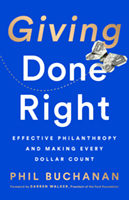In writing about the ways in which philanthropy can give voice to our communal optimism, I recently shared my belief that the wide array of goals across funders is not only inevitable; it’s also important. The problems on which foundations focus are interconnected. Pulling the thread of any one issue inevitably reveals tangled connections with others. Solving any one issue is likely to require a variety of approaches.
So my ears perked up when the John D. and Catherine T. MacArthur Foundation announced 100&Change. It’s a unique competition focused on a simple idea: to give away $100 million dollars in pursuit of one good idea. That’s an eye-popping sum for the vast, vast majority of nonprofits, whose budgets are often small. ($1.5 million is the median organizational budget among nonprofits receiving grants from foundations that have commissioned CEP to conduct a Grantee Perception Report.)
That MacArthur didn’t restrict the program by issue, field, geography, or even sector makes it a wide open opportunity to “make real progress toward solving a critical problem of our time,” as the Foundation puts it. It also makes the program a sort of Rorschach test for opinions about philanthropy — both from those in the field and those outside of it. ![]()
As I’ve spoken to folks about the initiative, I’ve encountered a few reactions that seem to be common. Given what I’ve heard, I think that if MacArthur can continue the level of transparency that they’ve started out with, the Foundation has the opportunity to create an important dialogue about fundamental choices faced by donors in choosing an approach. Here are a few of the reactions that I’ve heard the most — several of which, I share myself.
“It’s not enough.”
“$100 million may be big, but it’s not that much money given the scale of the issues.” “It’s a tiny fraction compared to the size of public spending.” These seem to be common refrains.
There’s truth here, of course. (For example, the gift is less than a third of the $325 million that New York City recently proposed to spend to create a fleet of ferryboats to connect all five boroughs, ease congestion on the city’s subway system, and improve its commute challenges.) That argument, though, diminishes how different a scale this grant will be from most grantmaking. In 2015, there were only 19 gifts by individuals of $100 million in value or more, as tracked by The Chronicle of Philanthropy.
“It’ll go to a big institution.”
$100 million is a very large amount of money, and there are questions about how much it would skew any organization’s budget. I can see how it would become easy to assume that therefore the process will inevitably lead to the selection of an organization with an already huge budget, more ready to absorb a sum of that size. That worry is not unfounded: of those 19 individual gifts exceeding $100 million last year, 15 went to institutions of higher education, generally already well-endowed universities like Harvard and Yale. (And, of course there’s the related debate about whether those already rich institutions are those most deserving of more money.)
I had this initial reaction, too. But MacArthur certainly didn’t restrict the competition based on organization size, and there are alternatives. Inside Philanthropy’s David Callahan makes this point well in suggesting to MacArthur that they prioritize selection of a collaborative approach.
“$100 million is easy to waste.”
This reaction can basically be summed up in one word: Zuckerberg.
Yes, a ton went wrong in Mark Zuckerberg’s $100 million grant to Newark’s public schools, prominently the lack of bottom-up engagement in Newark or connections to the communities and students that should have benefited. Dale Rusakoff wrote a whole book on it!
Ruth McCambridge at Nonprofit Quarterly emphasizes in her reaction to 100&Change the “futility of a wonderful idea without community roots.” I share this worry. Our research at CEP on funder-grantee relationships highlights the importance of foundations having a strong understanding of the social, cultural, and economic context of their grantees and the issues with which they’re working.
“Corporations?”
While MacArthur makes it clear that, as with any foundation grant, the benefit can’t flow to private entities, the possibility of an award to a corporation reinforces the current enchantment with sector-blind approaches. OK, I admit I share this reaction, too, and I do hope that MacArthur chooses a nonprofit (or a group of nonprofits). In so doing, they would emphasize the important public-good work that by definition is the distinctive and important work of the nonprofit sector.
“It’s about innovation.”
Finally, I’m amazed in my conversations about 100&Change by how quickly people assume that MacArthur must only be looking for a new innovation. I don’t see that written into their guidelines. So an award that focuses on scaling an effort that already has real evidence of success seems like a possibility to me. Whether “it has to be something brand new” is an unwritten, underlying criterion of the competition will be an interesting part of the conversation going forward.
…………..
And with that, my mind returns to questions of criteria — “how will they choose?” As I’m sure many did, I looked at the list of judges, which, to its credit, the Foundation has made public on its website. Was there a common thread? Were they all experts on innovation? Seemingly biased toward the private sector or nonprofits? All representatives of big organizations? Nope. Nope. Nope. They’re diverse in background, expertise, sector, and — I imagine — values, interests, and motivations.
Those judges will face all the fundamental tensions present in the questions above, and many more. I hope MacArthur will be very transparent about the debates through which the judges are forced to resolve those tensions into a decision about what grant will create the greatest impact. (Or, at least as transparent as they have been about the how they’ll execute the process. Here you can see the couple pages of mathematical formulas explaining the statistical normalization they’re using to ensure fairness in judges’ scoring.)
Why does that matter? Because there just isn’t a single right answer to the question of the “best” approach to social impact, and yet the evaluation panel is going to have to come up with just one answer — for now. If the Foundation achieves transparency in the “why” of the selection, it will make for an important case study of how individuals entrusted with immense philanthropic responsibility negotiate competing issues, goals, values, and approaches that are at heart of the often invisible choices that funders make every day in deciding how to focus their work. And it would give all of us an opportunity to reflect on how we’d resolve those questions, and why.
In a grant of this size, MacArthur is making a bet on the potential for a big money gift to change the world. I hope they make an equally large bet on the transparency that could stimulate an important learning conversation about the underlying choices every funder faces in philanthropy. ![]()
I have my fingers crossed.
Kevin Bolduc is vice president, assessment and advisory services, at CEP. Follow him on Twitter at @kmbolduc.










